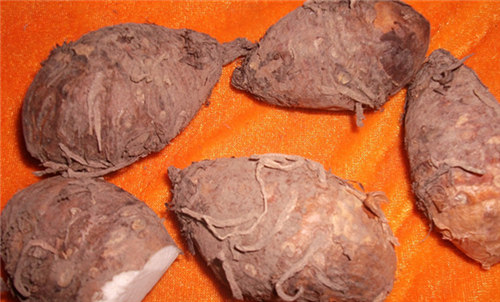Also known as Typhonium Rhizome or Rhizoma Typhonii, it refers to the tuber of Du Jiao Lian (Typhonium giganteum Engl.), which is a perennial plant of the family Araceae. The tubers are oval in shape, 2 to 5cm long and 1 to 3cm in diameter. The surface is from white to yellow-white, slightly coarse, covered with round stripes and fibrous root scars, and with remnant stem and bud scars at apices. The mealiness tuber is solid and with white section. Else, it is odourless, mild, acrid, and tingling. This herb is collected during Autumn, fibrous roots and skin off, washed clean, fumigated with sulphur, and dried in the sun.
Zhi Fu Zi refers to Prepared Aconite Root, which is the lateral root of rhizome of Chinese monkshood. It is acrid, sweet and hot in nature. Thanks for its excellent functions on restoring devastated yang, assisting yang to supplement fire, and dispersing cold to stop pain, it is hailed as The king of Warming Herbs. But Fu Zi (Aconite Root) is considered poisonous and need to be used with extreme care. It should be avoided for pregnant women and those of hyperactivity of yang due to yin deficiency group. In addition, it contradicts to Ban Xia (Pinellia Rhizome), Gua Lou (Trichosanthes Fruit), Bei Mu (Fritillaria Bulb), Bai Lian (Radix Ampelopsis Japonicae), and Bai Ji (Bletilla Rhizome).
WHAT'S TYPHONIUM RHIZOME USED FOR?
It is acrid, sweet and hot in nature. Please also note that it is poisonous. It involves with channels of stomach and liver. It is capable of expelling wind-phlegm, arresting convulsion, relieving toxicity, dissipating nodules, and stopping pain. Regular uses and indications include stroke, Bell's Palsy, tetanus, Migraine, Rheumatoid Arthritis, Rheumatic Arthritis, spasm, crewels, and snake bite, etc. Regular dosage is from 3 to 6 grams in decoction, and 0.5 to 1 grams in powder.
NATURAL BEAUTY EFFECT
Besides above-mentioned main functions, this herb is able to remove melanoma. This method is very simple to follow too. Grinding into powder, mix with honey, plaster on a paper and then mask them on your face before sleeping. Combining with the appropriate sun block in the daytime, the result will be better. "Ben Cao Jing Shu" ever said that it is dry and ascending in nature, which makes it positive among so many wind herbs. Ascending is the nature of wind. Combined with its dispersing and acrid nature for clearing damp, its medicinal momentum reaches the top and covers all conditions on face.
FORMULAS FOR STROKE AND BELL'S PALSY RECOVERY
From the TCM point of view, the causes of stroke lies in long-term Qi-blood deficiency and yin yang imbalance in heart, liver and kidney, which blocks the normal circulation of Qi and blood. Due to lacking of moistening and nourishing, the liver-yang rise suddenly and sharply, which makes for the occurring of wind. Thus blood rampages through the channels along with reversed flow of Qi, phlegm, and fire.

Typhonium Rhizome
Bai Fu Zi is hardly limited only for stroke and Bell's Palsy recovery. Actually it is widely used in the treatments of Zhong Feng, which refers to stoke and patterns hit by wind pathogen. When stroke and Bell's Palsy are involves, it is wind that is the main culprit from the perspective of Traditional Chinese Medicine (TCM). So, to cure similar diseases, expelling wind would be the immediate task to be deal with.
Modern pharmacological research reveals that this herb can be used as calcium channel blockers, bradycardic, and anti-inflammatory agent. Clinically it is widely used for treating Epilepsy, cerebral thrombosis, and unknown migraines. One of representative formula to treat stroke and sequelae is Zhong Feng Hun Chun Wan, which is a Chinese patent medicine. Main symptoms and signs are insensible feeling of hands and skins, Facial Paralysis (Bell's Palsy), babble, slobbering, and Hemiplegia.
Herbs used in Zhong Feng Hun Chun Wan include Dang Gui (Dong Quai), Chuan Xiong (Szechuan Lovage Root), Hong Hua (Safflower Flower), Tao Ren (Peach Seed), Ji Xue Teng (Millettia Vine), Tu Bie Chong (Wingless Cockroach), Jiang Can (Silkworm), Dan Shen (Red Sage Root), Mu Gua (Chaenomeles Fruit), Ren Dong Teng (Honeysuckle Stem), Di Long (Earthworm), Chong Wei Zi (Semen leonuri), Chuan Niu Xi (Szechuan Achyranthes Root), Quan Xie (Scorpion), Wu Gong (Centipede), Shen Jin Cao (Clubmoss), Wei Ling Xian (Clematis Root), Luo Shi Teng (Star Jasmine Stem), and Jin Qian Bai Hua Se (Agkistrodon).

![Diseases, Symptoms, tcm, [tcmwindow.com]](/uploadFile/adImg/2015/11/11/f5cbfcc0-4df5-4646-9b9a-f316651a0199.jpg)





